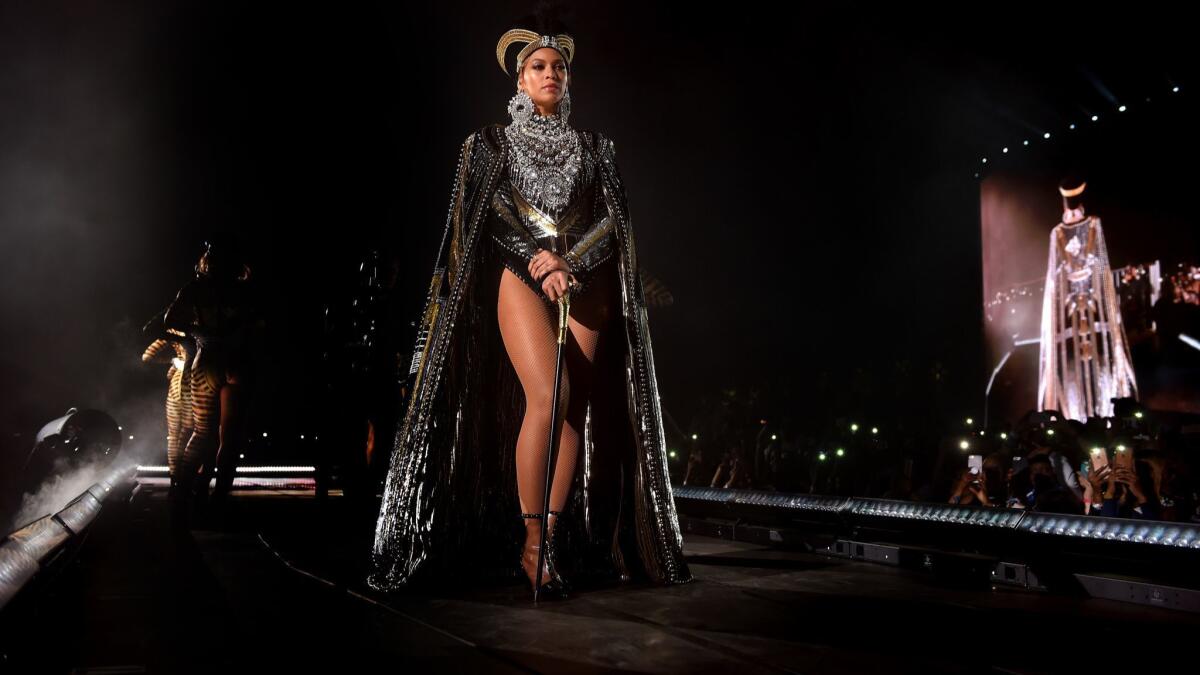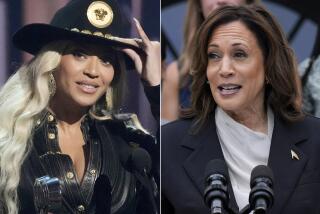Beyoncé’s refusal to shrink her blackness made her Coachella showing revolutionary
A quarter into Beyoncé’s triumphant, charged showing at the Coachella Valley Music and Arts Festival came a particularly poignant moment.
With the pop star floating high above the crowd via a hydraulic crane, Nina Simone’s mournful version of “Lilac Wine” poured from speakers as two muscular dancers were intertwined in movement, a subtle nod to the fact that her April 14 Coachella debut came as Simone was being inducted into the Rock and Roll Hall of Fame in Cleveland, more than a half century after “Lilac Wine” was released.
After Simone’s vocal faded, Beyoncé reemerged onstage to lead the 100 dancers, singers and musicians backing her through a joyful “swag surf” — the title of a dance inspired by Fast Life Yungstaz’s similarly named 2009 hit.
No doubt only a very specific constituency of the Coachella audience, as well as those watching at home, were aware of the dots Beyoncé was trying to connect.
“Everyone has made a point to say how ‘explicitly black’ the show was, and while I appreciate that Beyoncé has always been so inherently black and southern in her work,” said Michael Arceneaux, author of “I Can’t Date Jesus: Love, Sex, Family, Race, and Other Reasons I’ve Put My Faith in Beyoncé.”
“[Coachella] was really special because it felt like a culmination of her entire career.”
Twenty years into her career, Beyoncé continues to break new ground, and her billing at Coachella was no different as she became the first black woman to headline the festival. “Ain’t that ’bout a bitch,” she said during her debut the first weekend.
Thus, Beyoncé played directly to her black audience, with every element of her show steeped in cultural meaning that showed a singer not just elevating her craft but going through great lengths to pay homage to those that came before her — a bold approach from a performer whose every move dominates the pop cultural conversation. And Beyoncé’s steadfast determination to bolster her own audience rather than extend a hand to a new one has elevated her to near mythic status.

Considering that the stages at Indio’s Empire Polo Club have long had a reputation for reflecting the tastes of its largely white audience — it took nearly 10 years for the festival to so much as have a black headliner and that was Prince in 2008 — Beyoncé could have just played it safe and stuck to crowd-pleasing hits.
Instead, she took a risk and built a visually grand set immersed in blackness — a performance about educating as much as it was spectacle. It was a conscious decision by the singer who, according to her mother, wanted “to do what’s best for the world and not what is most popular.”
And what was best for the world, Beyoncé thought, was to celebrate the black art that has long influenced popular culture despite its architects — especially the female ones – not always getting proper due from white America.
“Beyoncé was not the first black woman Coachella could have gotten to headline. They could have called Janet [Jackson], they could have called Missy [Elliott]. Black women have often seen their work dismissed and are rarely recognized as masters of their own craft,” offered Candice Benbow, the writer and theologian behind the “Lemonade” syllabus, which applied an academic lens to the singer’s defiant 2016 album.
Themed as an homage to the spiritual experience and rich culture of homecoming celebrations at historically black colleges and universities, Beyoncé spent nearly two hours tearing through her discography while unpacking the black musical history that has informed her artistry.
Chopped and screwed beats from her native Houston, the brassy horns and energetic bounce music of New Orleans, traditional hip-hop flourishes, dancehall and the Afrobeat rhythms pioneered by Fela Kuti were worked into her biggest hits that with the aid of a spirited marching band turned the mainstage into a jubilant celebration of black art.
“This was a show that the bulk of the audience who comes to Coachella would not understand. It was a performance for them, but it was a party for us,” said Benbow.
“When have we ever had a superstar on that large of an international stage specifically doing a performance that was steeped in blackness and black culture” she continued. “It was, and remains, a moment.”
Critics heralded the showing. “There’s not likely to be a more meaningful, absorbing, forceful and radical performance by an American musician this year, or any year soon” the New York Times declared. L.A. Times critic Mikael Wood wrote, “The scale, the reach, the detail — and the feeling — simply put it on a level higher than those on which most other artists operate.”
That Beyoncé continues to eschew pop star conventions in favor of specificity comes as little surprise to anyone who has followed her career.
Her lore can be boiled down quite easily: child prodigy managed by her business savvy father and styled by her mother leads chart-topping girl group Destiny’s Child, breaks out solo, marries rap king (Jay-Z) and becomes international pop royalty revered for her athletic showmanship and audacious anthems of female empowerment.
Yet recent years has seen her toy with the notion of pop stardom as her celebrity increasingly transcended her music.
Her latest work, such as the aforementioned “Lemonade” and 2013’s self-titled “visual album” — both released on her own terms with moves that disrupted tradition — have shown a singer more interested in crafting revelatory work than chasing pop perfection.
Beyoncé at present is about experimentation and making deeply personal statements that center on black womanhood and overt meditations on sex, racial politics, religion, family and feminism. She’s making some of the boldest, most nuanced work of her solo career.
And it’s her existence as a successful black woman in an industry where whiteness dominates that has brought extra attention (and even some scrutiny) to her moves.
Take the vitriol over “Formation,” the lead single off “Lemonade.”
The singer was labeled racist and a cop hater for the song in which she proudly sings “I like my Negro nose” and positions herself as a black Bill Gates. She sparked some of the most intense backlash of her career when she performed the cut at the Super Bowl in 2016 with a routine that incorporated the black power salute and paid homage to Malcolm X while wearing a militant leather ensemble inspired by the Black Panthers and Michael Jackson.
Although it was a quick blip in what became a year that saw her sell out stadiums globally as “Lemonade” was extolled by fans, critics and academics, the brouhaha was a reminder of how often black artists have found themselves chastised for expressing themselves on mainstream stages.
At Coachella, “Formation” came immediately after “Lift Every Voice,” which is widely regarded as the black national anthem. This was the singer’s way of confirming just who she is performing to — and for, in case it wasn’t clear. It’s long removed from her entry as an R&B ingénue 15 years ago at the height of her girl group success.
“She had to navigate blackness very differently and uniquely in the beginning of her career because that’s literally the only way in which she was able to ascend to the place where she currently is now,” said Benbow.
“That’s not a critique of [Beyoncé], but it is an indictment of the ways in which all fashions of mainstream society — whether it’s the entertainment business or our own personal corporate careers — requires us to navigate blackness to make white folks feel more comfortable. Beyoncé is no longer doing that.”
Beyoncé’s refusal to shrink her blackness has yielded some of her most celebrated work, not that anyone tuned into the Grammys or pop radio could tell.
We are in a time of R&B and hip-hop prominence, yet in the past decade, Beyoncé has been just one of three black female singers to land a No. 1 single on the Billboard Hot 100 as well as to top the album charts as a lead artist. And when she lost the Grammy for album of the year to Beck in 2015 and to Adele last year, it reignited a conversation about how black women are rewarded for their craft (she would have been the first black woman to win the honor in nearly 20 years).
Maybe its why she decided to insert the words of Malcolm X on “Lemonade,” words that blared across the polo fields as she strutted along a specially erected catwalk in the middle of a mostly white audience: “The most disrespected person in America is the black woman. The most unprotected person in America is the black woman. The most neglected person in America is the black woman.”
“Her performance didn’t have to be the one that she did. She could have done anything and we would have screamed and said she slayed us because she would have,” Benbow said. “To center our experiences — particularly in this divisive moment that we’re in — was jaw-dropping. She showed the world that for as much as they love black culture, they can’t value it without valuing us.”
More to Read
The biggest entertainment stories
Get our big stories about Hollywood, film, television, music, arts, culture and more right in your inbox as soon as they publish.
You may occasionally receive promotional content from the Los Angeles Times.











